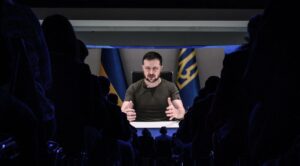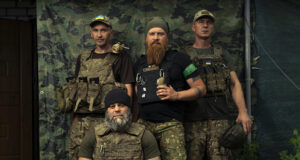As Nato members and their Asia-Pacific allies convene today to discuss the bloc’s expansion and future strategy, the Ukrainians are destined to be disappointed — insofar as membership is concerned at least. In an interview on Sunday, Biden said it was “premature” to allow them to join in the middle of a war. The reason is fairly obvious. As the former US Nato ambassador Ivo Daalder put it: “Bringing Ukraine into the alliance is tantamount to joining the war.” Their membership would risk a direct, potentially nuclear, conflict between Nato and Russia on European soil. “If the war is going on, then we’re all in war,” Biden said, referring to the alliance’s commitment to mutual defence. “We’re at war with Russia.”
Aside from a few Eastern Euripean and Baltic countries, this is a scenario no one is ready for — though the longer the war drags on, the greater its inevitability. Avoiding an all-out war hinges on Nato and Russia maintaining the fiction that the two sides aren’t already engaged in a proxy war — and one that Nato seems intent on escalating.
The United States did nothing to dispel this impression with its recent decision to provide cluster bombs to Ukraine, a weapon banned by a convention signed by more than 120 countries (including more than two-thirds of Nato members) due to its horrific track record of causing thousands of civilian casualties; in countries such as Laos, cluster bombs continue to maim and kill civilians, 50 years after the end of the Vietnam War. The US, Ukraine and Russia, which is also accused of having used cluster munitions in Ukraine, are among the few to have not signed the convention.
While Nato as a group is unlikely to endorse full Nato membership in Vilnius, it is however expected to reaffirm its commitment to providing long-term military assistance to Ukraine: Nato integration in all but name. In other words: more war. But perhaps we shouldn’t be surprised. As the saying goes, if all you have is a hammer, the whole world looks like a nail — and Nato has by far the world’s biggest hammer. Even though it encompasses just over 10% of the world’s population, it accounts for 55% of global military spending; it is by its very nature unable to conceive non-militaristic solutions to the ongoing conflict.
Yet if, as many have pointed out — and as even Fiona Hill, security advisor to several former US presidents, has admitted — no one can win this war and there is no alternative to a diplomatic solution to end the bloodshed, why are we continuing to rely on an organisation that evidently represents an obstacle to peace? Such questions are precisely the ones that will be carefully avoided during the two-day summit: has the Ukrainian-victory-at-all-costs strategy really benefited Ukraine? How do we bring an end to the war? And, most fundamentally, what is Nato for?
Nato presents itself as a purely “defensive alliance… working for peace, security and freedom”. The reality, however, is quite different. Aside from the fact that its most powerful member and de facto leader, the US, has bombed more countries than any other nation, Nato itself has a rather violent track record. In 1999, Nato began its 78-day illegal bombing campaign of Yugoslavia, the first act of aggression against a sovereign state committed in Europe since the Second World War. Many civilian targets were hit, including 48 hospitals, 70 schools, 18 kindergartens and 35 churches. Overall, hundreds of civilians were killed, including 81 children. Since then, Nato has been involved in several other conflicts, most notably Afghanistan and Libya. None had anything to do with defending its members from external aggression; in all these cases, Nato was quite clearly the aggressor.
And so it’s far from clear how exactly Nato is providing “security” to Europe. On the contrary, some are convinced that Nato provoked Russia’s invasion of Ukraine by aggressively expanding eastward, systematically ignoring Russia’s warnings over the years. This represented a gross violation of the principle that had inspired the entire European security architecture since the Seventies: the indivisibility of security — that is, the notion that the security of Nato states and the Soviet Union (subsequently Russia) was “inseparably linked to that of all the others”, and could not come at the expense of another state’s security. In other words, Nato played a crucial role in unravelling Europe’s security architecture and creating the conditions for the largest conflict in Europe since the Second World. How does this square with the notion that Nato is there to guarantee Europe’s peace and security — or that, today, it represents a “bulwark” against the very chaos that it helped create?
This is particularly disturbing given Nato’s stated intention of expanding its activity into the Indo-Pacific region, which will obviously antagonise China. The current Nato Secretary-General, Jens Stoltenberg, is a well-known anti-China hawk. In February, he drew parallels between Russia’s invasions of Ukraine and China, saying “we should not make the same mistake with China”, implying that Beijing should be strategically circumscribed by the West.
To this end, Nato is strengthening its cooperation with its partners in the Indo-Pacific region — Australia, Japan, the Republic of Korea and New Zealand — and is also hoping to open a Nato liaison office in Tokyo, the first of its kind in the region. The leaders of these four countries will also attend the Vilnius event to underscore their deepening relationship — as they did last year in Madrid. For the same reason, Germany will, for the first time, be sending troops to Australia as part of joint drills with some 30,000 service members from 12 other nations.
Beneath the surface, the creation of this “global Nato” is further evidence of the fact that the alliance’s strategy is increasingly indistinguishable from Washington’s — focused less on defence and more on great-power confrontation. In a scathing statement, Australia’s former prime minister Paul Keating labelled Stoltenberg a “supreme fool” for wanting to “export [Nato’s] malicious poison to Asia”. He wrote: “With all of Asia’s recent development amid its long and latent poverty, that promise would be compromised by having anything to do with the militarism of Europe — and militarism egged on by the United States… Stoltenberg conducts himself as an American agent more than he performs as a leader and spokesperson for European security.”
Moreover, Keating noted that Stoltenberg’s aggressive anti-China stance wasn’t shared by France, the largest EU state, which just a few days ago issued a statement insisting that Nato should remain geographically confined to the North Atlantic. Macron has been opposed to an increased Nato focus on China for years, arguing in 2021 that “Nato is a military organisation, the issue of our relationship with China isn’t just a military issue. Nato is an organisation that concerns the North Atlantic; China has little to do with the North Atlantic”.
But if Stoltenberg can so openly disregard the opinion of such an important member, who exactly does he represent? How does Nato actually work?
Nato’s principal decision-making body is the North Atlantic Council, which brings together representatives of each member country and “oversees the political and military process relating to security issues affecting the whole Alliance”. Formally, “all Nato decisions are made by consensus, after discussion and consultation among member countries”. In reality, however, neither the founding treaty nor any other Nato basic document prescribes a decision-making rule. This allows the alliance to present its decisions as unanimous and consensual even when they’re not. In theory, every member state has a de facto veto right, but in practice its use has been rare.
This relates to another of Nato’s myths: the equality of all member states. This may be formally true, but countries such as Albania and Montenegro are hardly on an equal footing with the US. As a recent study by the Swedish Defence Research Agency notes, “the US has been an uncontested leader of the Alliance and an informal grouping of big Allies has dominated many crucial Nato decisions”.
In fact, many believe that Nato has been one of the key institutions through which the US has exercised its control over post-war Western Europe. As the researchers Rajan Menon and William Ruger argue in a recent paper: “Nato’s continued existence ensures that Europe remains a strategic subordinate to the US, which explains why the US, though it has complained often about inequitable burden sharing, has never demanded a dramatic increase in European military power, let alone a Europe with an autonomous defence policy”. It is no coincidence, in this sense, that Nato’s revamping on the heels of the Russia-Ukraine conflict has led to a greater degree of European “vassalisation” to the US than ever before, according to the European Council on Foreign Relations.
In this sense, it is striking to note the deep ideological linkages between Nato and the European Union, another of the institutions through which Washington has historically exercised its influence over Europe. This has become embarrassingly apparent under the presidency of Ursula von der Leyen, dubbed “Europe’s American president” by Politico late last year. Over the years, von der Leyen has worked tirelessly to keep Brussels committed to Washington’s hawkish stance toward Russia and China — so it’s perfectly fitting that reports suggest she has been selected to take over as Nato’s next chief.
Given von der Leyen’s track record, she’ll make Stoltenberg look competent in comparison. During her time as the Germany’s defence minister, von der Leyen was accused of allowing lucrative contracts worth millions of euros to be improperly handed out to consultants — and then of deleting all the message from two of her smartphones before returning them to the defence ministry. This seems to be common practice for von der Leyen. For the past two years, von der Leyen has systematically refused to release the text messages she exchanged, as president of the European Commission, with Pfizer CEO Albert Bourla, in which she personally negotiated the purchase of up to 1.8 billion doses of the BioNTech/Pfizer vaccine, worth a staggering €35 billion. Overall, we can probably expect Nato’s management under von der Leyen to be even less transparent — and more prone to America’s interests — than ever.
In the meantime, it is clear the Ukraine conflict has represented a boon for the US and for the transnational military-industrial interests represented by Nato. And that is in Washington’s every interest for the war to go on for as long as possible, and for Europe to be kept in a state of permanent instability. This is why, when it gathers today, we can expect Nato to continue pushing for an escalation of the conflict in Ukraine. Why risk ending the war when you could be cashing cheques — both financial and diplomatic — for months and even years to come?
Disclaimer
Some of the posts we share are controversial and we do not necessarily agree with them in the whole extend. Sometimes we agree with the content or part of it but we do not agree with the narration or language. Nevertheless we find them somehow interesting, valuable and/or informative or we share them, because we strongly believe in freedom of speech, free press and journalism. We strongly encourage you to have a critical approach to all the content, do your own research and analysis to build your own opinion.
We would be glad to have your feedback.
Source: UnHerd Read the original article here: https://unherd.com/



